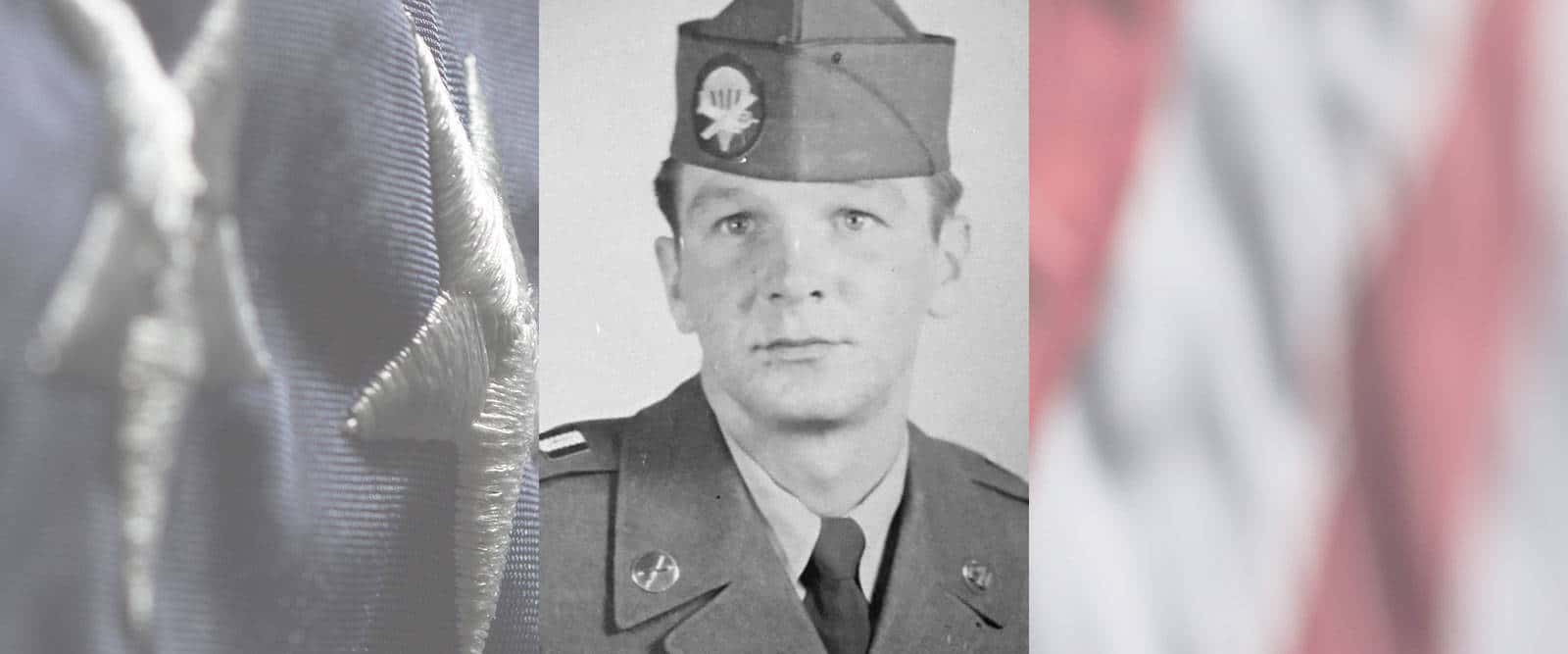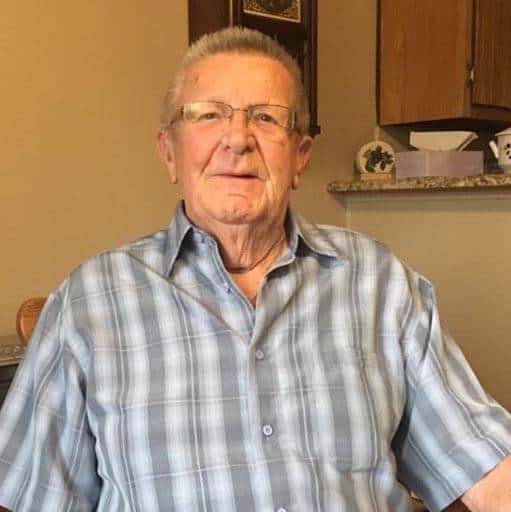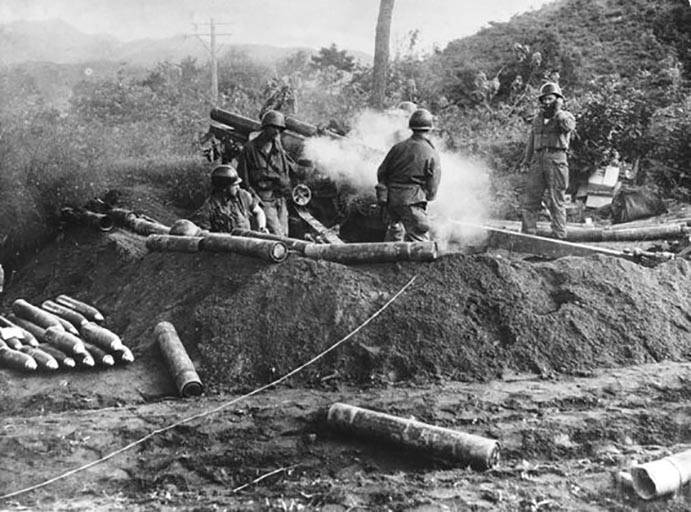U.S. Army Korean War Hanover Park, IL Flight date: 09/13/17
By Charlie Souhrada, Honor Flight Chicago Veteran Interviews Volunteer
Edgar (Dale) Kavanagh was born January 5, 1935, in International Falls, Minnesota – a town nicknamed “Icebox of the Nation,” for its notoriously long, bitterly cold winters. He grew up in a large family, including: his father, Albert (a house painter and barber), mother Lillian, two sisters, Ruth and Beverly and two brothers, Rodney and Daryl.
In 1950, his older brother, Rodney, moved to Chicago and encouraged Dale to follow. Taking his brother’s advice, Dale moved in with an aunt and uncle, and found work at the Union Bag and Paper Company making corrugated boxes. Two years after moving to Chicago, Dale again followed his brother’s lead and joined the Army.
“He enlisted in January and I followed in February,” Dale remembers. At first, the brothers both went Airborne, but their paths separated when their individual assignments became clear. “He dropped out of Airborne because he wanted to go with his buddies to Germany and didn’t want to go to Korea,” says Dale. “That’s where I was headed and I knew it. At the time we enlisted, the Korean War was going pretty good already and I wanted to be part of that.”
Dale had basic training at Camp Breckenridge in Kentucky, home of the 101st Airborne Division, an elite, light infantry division trained for air assault operations. Ironically, despite growing up in the nation’s “icebox,” he remembers basic was cold and everything was frozen. “Basic training was a little bit rough because I went in in February and it was still cold,” he says. “Every day was outside. Occasionally, we’d have training indoors. We had to take turns at night stoking the furnaces with coal!”
After 16 weeks of basic, Dale was sent to Fort Benning in Georgia for jump school, a conscious decision he made in a quest for higher pay and a sharp uniform. “One of my buddies that I grew up with joined the Army and became a paratrooper. I liked the looks of his uniform, the shiny boots and the cuffed trousers … that was neat!”
Dale’s first jump sticks with him to this day. “The first time we jumped, we were all suited up and it was a half-hour ride in the plane to the jump spot. The doors were open already, it was noisy and scary. Then we were ordered to stand and hook up. I was the first one in the door, one hand on each side, waiting for the jump master to hit me in the back and say ‘go!’ When the parachute opened, your feet went way up and hit your helmet. I never knew your body would spring into action like that. After we had that opening shock, it was beautiful floating down!” Three weeks later, Dale was bound for Tokyo on the troop transport, USS General W.H. Gordon. “It was a rough ride,” he says. “I saw waves 50 feet high, but the ship went right over them, never a bang or water over the sides. It was like a storm at sea-wind, but no rain. It was quite a sight.”
After a 14-day journey straight to Tokyo, he was issued his weapons and flown to Camp Wood in Japan. There, he was assigned to the 187th Airborne Regimental Combat Team (ARCT), 674th Field Artillery Battalion, where he served on a five-man, 105mm howitzer team.
He remembers the experience was filled with a lot of traveling between the base in Japan and fighting in the Kumwha Valley of Korea from a bunker for three or four months at a time. “There was nothing but hills, sand, rocks and narrow roads. In the winter, it was cold and in the summer, it was hot and humid.” After several months in the field, the troops would ship back to Camp Wood to clean their weapons, undergo more field training and perform a required monthly jump to earn their $50/month “jump” pay.
After the Korean War Armistice in July 1953, the U.S. Army, and Dale, stood watch and kept the peace. “You never knew when someone was going to start another war,” he laughs. “We never just sat around though, we were always doing something. If we cleaned our weapons yesterday, we’d do it again the next day!”
In February 1955, Dale was told his time was nearly up and he was sent back to the States on another 14 day journey, this time aboard the USNS Aiken Victory. Onboard, just like his father before him, he picked up extra pocket money by cutting hair for 50 cents a head. After landing in California, Dale traveled by bus to Fort Carson in Colorado, received his discharge papers, then headed back to Chicago. There, he resumed his old job at the Union Bag and Paper Company, earned his GED and met his future wife, Mary, through an army buddy.
“I was in the service with Mary’s brother, Kenny, and we were going to go roller skating as a group. I couldn’t do anything on roller skates, but she helped me. A couple of nights later, I said ‘I’m going to marry you!’” Mary may have laughed initially, but several months later, the two were married on November 26, 1955, less than a year after Dale returned from Korea.
Soon after his marriage, his new father-in-law helped him get a job as a meat packer in the Fulton Market District, where he worked for the next two decades. He supplemented the family’s income with construction jobs on the side. The extra funds came in handy as Dale and Mary welcomed three sons and one daughter over the years: Dan, Donald, Donna and David.
Eventually, Dale switched careers and became a building engineer at Alexian Brothers Medical Center in Elk Grove Village. He retired in 2004. The couple now lives in Hanover Park, with their daughter, Donna. They fill their days with work around the house, gardening and enjoying their beautiful grandchildren, Joe, Nicole, Jackie, Kelly, Trevor and Natalie.
Thank you for your service, Dale! We hope you enjoy your well-earned, much-deserved Honor Flight!






